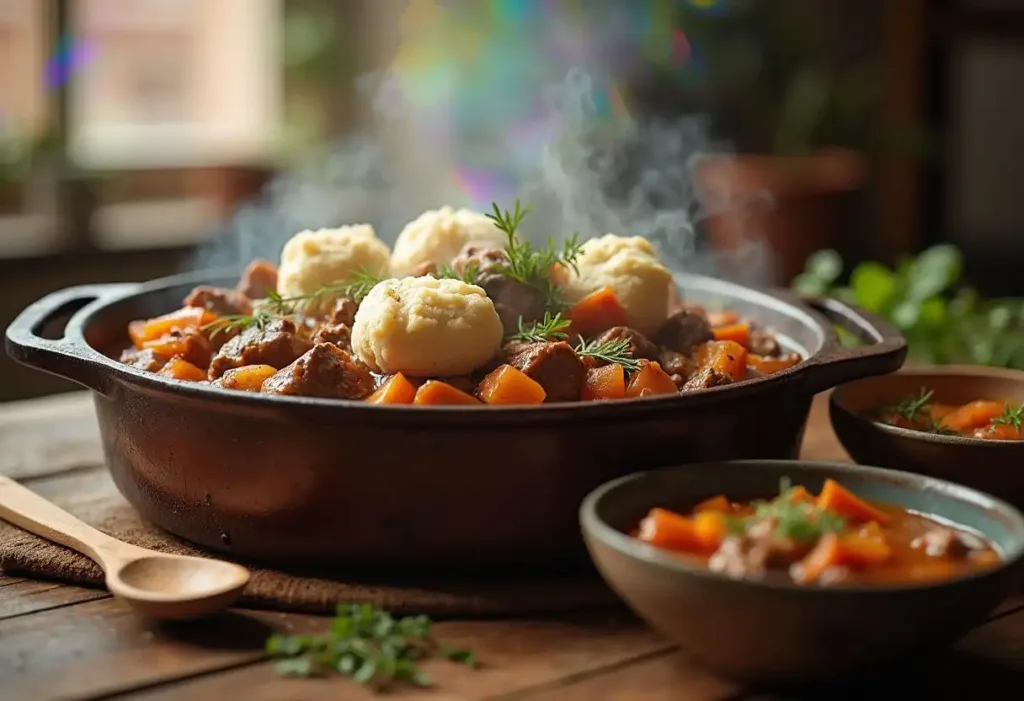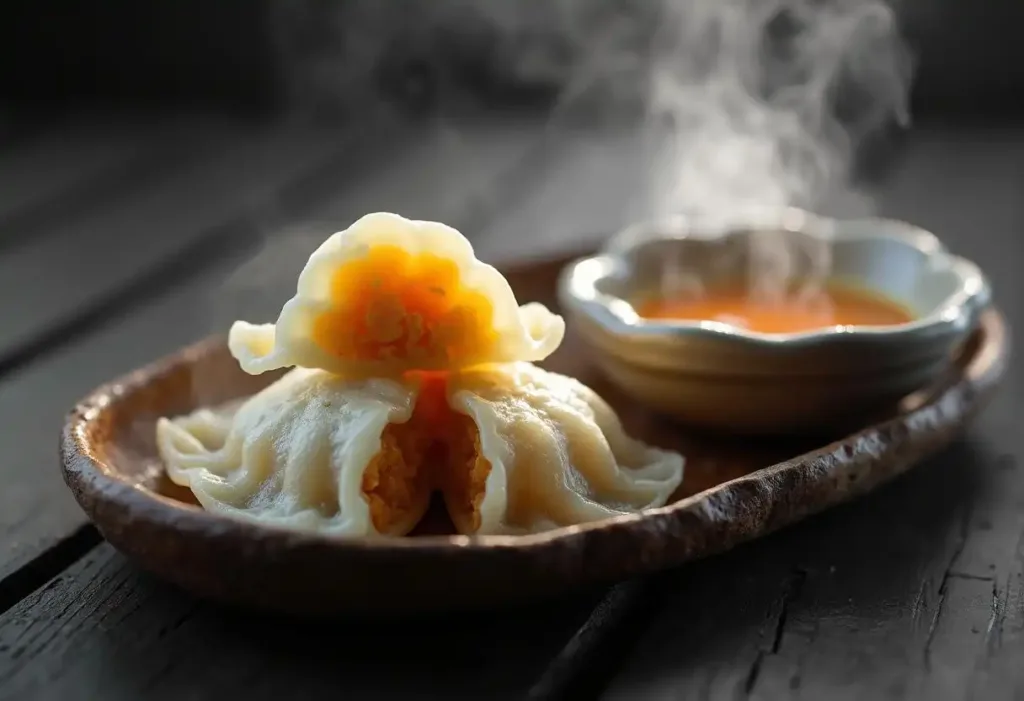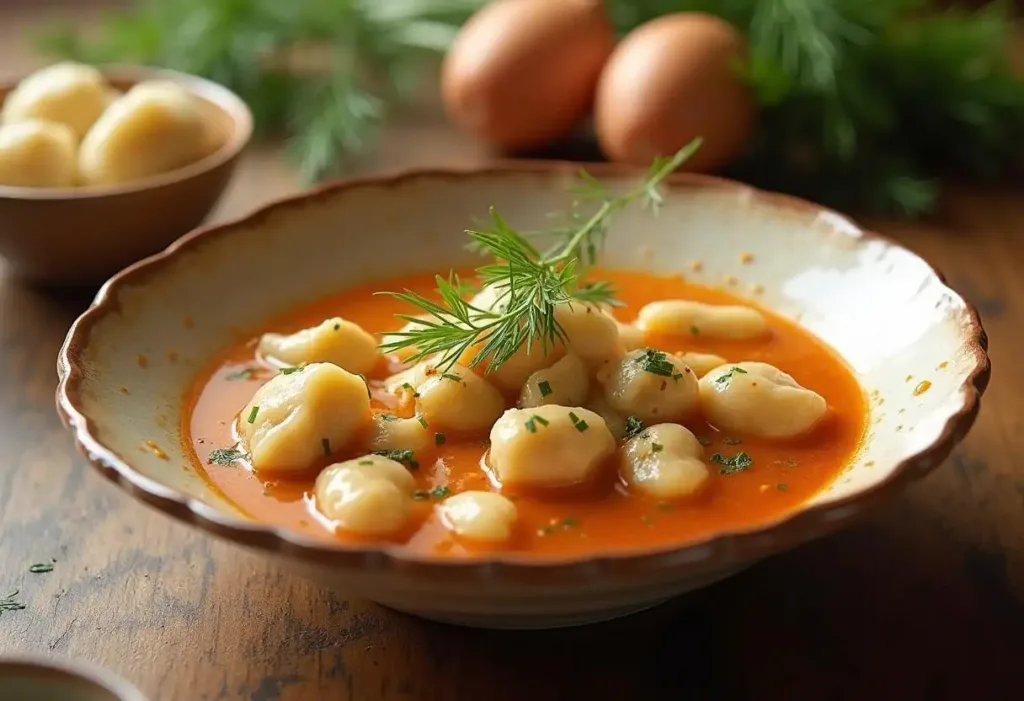Okay, friends, let’s talk about something near and dear to my comfort-food-loving heart: dumplings! Those fluffy little clouds bobbing happily on top of a rich, savory stew? Mamma mia, that’s good stuff! Especially on a drizzly Portland day. But let’s be honest, haven’t we all made dumplings that could double as hockey pucks? Yeah, me too. My son, Mr. Picky Eater, definitely notices, and even my goofy husband can’t pun his way out of a dense dumpling situation. Often, the culprit is getting the suet ratio wrong. So, let’s solve this mystery together: **How much Atora Suet for dumplings?**
Getting that perfect balance is *key* for light, airy dumplings that soak up all that delicious gravy. Too little suet? Dense disappointments. Too much? Greasy little messes. No worries, amici! We’re going to figure out exactly how much Atora suet you need, plus I’ll share my best tips (maybe even one from Nonna!) to guarantee dumpling glory every single time. Get ready to make your stews even cozier!
What is Atora Suet Anyway? A Quick Primer
Before we measure, let’s quickly chat about what this Atora suet stuff actually *is*. Sounds kinda old-fashioned, right? Suet is basically the hard fat from around the kidneys of beef or mutton (sheep). Atora is just a super popular brand that shreds it up nicely for us, making it easy to use in recipes like dumplings, puddings, and pastries. (Yes, suet pastry is a thing!)
Why bother with suet instead of butter? Here’s the cool part: suet melts at a higher temperature. When those dumplings hit the hot stew, the suet melts slower, creating little pockets of steam inside. Voila! That steam is what makes the dumplings light and fluffy. Plus, it adds a subtle, savory richness that butter just doesn’t quite replicate in the same way. It’s the secret weapon for amazing dumplings!
The Definitive Answer: How Much Atora Suet for Dumplings?
Alright, the moment you’ve been waiting for! Drumroll, please… For those perfectly light, fluffy dumplings that Nonna would be proud of, the golden ratio is generally **half the weight of suet to the weight of flour**. Simple, right?
So, in practical terms (because who wants complicated math when dumplings are involved?):
For every **8 ounces (about 225g or roughly 2 cups) of self-raising flour**, you’ll want to use **4 ounces (about 110g or roughly 1 cup) of Atora suet**.
This 2-to-1 flour-to-suet ratio by weight hits the sweet spot. It gives you enough fat for richness and that lovely light texture, but not so much that things get greasy. It provides the structure they need to hold together while still being tender.
Now, remember, this is a fantastic starting point! Depending on humidity, the exact flour, or just how you like ’em, you might tweak it *slightly*. But stick close to this ratio, and you’ll be in dumpling heaven!
A Basic Dumpling Recipe to Get You Started
Now that we’ve cracked the code on “How much Atora Suet for dumplings,” let’s put it into practice! Here’s my go-to, super simple dumpling recipe:
Yields: About 8-10 fluffy dumplings (perfect for topping a family stew!)
Prep time: 10 minutes (Seriously quick!)
Cook time: 20-25 minutes
Ingredients:
- 8 ounces (approx. 2 cups) self-raising flour (make sure it’s self-raising!), plus a little extra for dusting
- 4 ounces (approx. 1 cup) Atora suet, shredded (the star!)
- Good pinch of salt
- About 4-6 tablespoons *ice cold* water (cold is key!)
Equipment:
- Big mixing bowl
- Measuring cups and spoons (or a kitchen scale for accuracy!)
- A regular dinner knife (Nonna’s trick for mixing!)
Instructions:
- Dry Mix: In your big bowl, whisk together the self-raising flour, Atora suet, and salt. Get it nice and combined.
- Add Water Carefully: Add the cold water a tablespoon at a time. Use your knife to gently cut the water into the flour mix – don’t stir vigorously! Keep adding water just until the dough *barely* comes together. It should look a bit shaggy and slightly sticky, not like smooth bread dough. Overmixing = tough dumplings!
- Shape ‘Em Up: Dust your hands lightly with flour. Gently scoop out portions of the dough (about the size of a golf ball) and quickly, lightly roll them into rough balls. Don’t pack them tightly!
- All Aboard the Stew!: Carefully drop the dumplings onto the surface of your simmering stew. Make sure the stew is gently bubbling, not boiling furiously. Give them a little space to puff up.
- Lid On, No Peeking!: Pop the lid on the stew pot *tightly*. Cook for 20-25 minutes. Resist the urge to peek! Letting the steam escape is the enemy of fluffy dumplings.
- Serve & Swoon: When the time’s up, your dumplings should be puffed up and cooked through (maybe gently poke one to check). Serve them up straight away with that delicious stew! Buon appetito!
Pro Tips for Dumpling Perfection
Want to really nail those dumplings? Here are a few extra tricks from my kitchen (and maybe one inspired by Nonna!):
- Self-Raising is Your Friend: Seriously, use self-raising flour. It has the baking powder already built-in, giving your dumplings that extra lift without any extra work. Easy peasy!
- Keep It Chill: Make sure your suet AND your water are cold. Cold fat = better steam = fluffier dumplings. I sometimes pop the suet box in the fridge for 10 minutes before I start.
- Hands Off!: The biggest mistake? Overworking the dough. Mix it *just* enough for it to come together. A light hand is key. Think gentle persuasion, not a wrestling match.
- Cold Water Splash: Use ice-cold water. It helps keep those little bits of suet solid until they hit the hot stew, maximizing the steam power.
- Steam Power!: That tight-fitting lid is crucial. Trapping the steam is what cooks the dumplings through and makes them puff up beautifully.
- No Peeking Allowed!: Nonna was very strict about this! Every time you lift that lid, precious steam escapes, and your dumplings might get sad and dense. Set a timer and trust the process!
Troubleshooting Common Dumpling Problems
Even the best of us have dumpling disasters sometimes (pass the Pinot Grigio!). If yours aren’t quite right, here’s a quick fix guide:
- Hockey Pucks (Dense/Heavy): Usually means not enough suet, too much mixing, or using warm water. Stick to the ratio, mix gently, keep things cold! Check out these simple fixes if you find your Atora dumplings are hard.
- Greasy Spoon Dumplings: Probably too much suet, OR the stew wasn’t simmering enough, so they just sat in warm liquid instead of steaming. Ensure a gentle simmer!
- Falling Apart Flops: Likely too much water in the dough, making it too loose. Or maybe you mixed it too much? Add water gradually next time.
- Half-Baked Blunders (Uneven Cooking): Usually a lid issue! Either the pot wasn’t covered tightly enough, or someone peeked (tsk tsk!). Make sure that steam stays trapped!
Don’t get discouraged! Each batch is a learning experience. You’ll be a dumpling master in no time!
Variations to Make Your Dumplings Extra Special
Feeling fancy? Or just want to shake things up? Basic dumplings are great, but here are some easy ways to add extra yum:
- Herby Delights: Stir in a tablespoon of chopped fresh herbs with the dry ingredients. Parsley is classic, thyme loves beef stew, chives add a delicate oniony note. Mix and match!
- Cheesy Goodness: Fold in about 1/4 cup of grated sharp cheddar or salty Parmesan into the dry mix. Cheesy dumplings? Mamma mia, yes!
- Garlic Bomb: Add a finely minced clove of garlic (or 1/2 tsp garlic powder) to the flour mixture. Perfetto!
- Spicy Kick: Feeling bold? A pinch of cayenne pepper, some chili flakes, or even a dash of smoked paprika stirred into the dry ingredients adds a lovely warmth.
Have fun with it! Dumplings are forgiving canvases for flavor.
Nutritional Benefits and Considerations
Okay, let’s have a little real talk moment. Suet dumplings are comfort food royalty, pure deliciousness… but they aren’t exactly hitting the top of the health food charts. And that’s okay! Food is about joy and comfort too, right? But it’s good to know what we’re eating.
What’s in Atora Suet?
So, Atora Suet is mostly fat – specifically, the hard fat from around beef kidneys (or there’s a veggie version too). This means it’s high in calories and saturated fat. It does contain some vitamins that dissolve in fat (A, D, E, K), but not huge amounts. Here’s the skinny (pun maybe intended?):
- High Calorie/Fat: Yep, suet packs a punch calorie-wise because it’s mostly fat, including saturated fat.
- Some Vitamins: Contains small amounts of those fat-soluble vitamins.
- Not Much Else: Very little protein or carbs, and basically zero fiber.
Storage and Shelf Life:
- Unopened Box: Keep it in a cool, dark pantry. No need to refrigerate before opening. Check the date, but it usually lasts ages. More info from Bradley’s Foods.
- Opened Box: Once you open it, keep it sealed tightly! The fridge is a good bet to help it last longer, maybe 4-6 weeks. Check out storage tips via Caterite. If it smells weird or looks yellow/rancid, toss it!
Is Suet Dumplings a Healthy Choice?
Look, are they kale salad? No. Are they delicious and comforting and totally fine as part of a balanced life? Absolutely! Here’s how I think about it:
- Treat Yourself!: Dumplings are a treat! Enjoy them when you make that lovely stew, but maybe not every single day. Moderation, amici!
- Balance is Beautiful: Pair that stew and dumplings with lots of veggies! Load up the stew itself, or serve a big green salad alongside.
- Portion Power: Maybe just have one or two fluffy dumplings instead of five? Savor them!
- Cooking Method Matters: Simmering them on top of the stew is way better than deep-frying dumplings (which is… a thing?).
- Lighter Swaps?: Atora makes a light vegetable suet which is lower in saturated fat. You could also try experimenting by replacing *some* (not all!) of the suet with grated cold butter or shortening, but the texture might change.
It’s all about enjoying good food without guilt, but also being mindful. Make smart choices most of the time, and savor those comforting dumplings when you have them!
Creative Variations for Suet Dumplings
Okay, let’s put on our creative aprons! Basic dumplings are fantastic, but sometimes you wanna add a little *oomph*, right? Let’s jazz things up and make those dumplings sing an Italian opera (well, almost!).
Adding Herbs and Spices
- Go Green (Herbs!): Fresh herbs stirred into the dry mix are *chef’s kiss*! Think about what stew you’re making:
- Parsley & Chives: Like the little black dress of herbs – goes with everything! Bright and fresh.
- Thyme & Rosemary: Perfect partners for beef or lamb stews. Earthy and aromatic.
- Sage: Got a chicken, pork, or mushroom stew? Sage adds a lovely, slightly peppery note.
- Spice It Nice: A little spice adds warmth and intrigue:
- Smoked Paprika: Adds gorgeous color and a subtle smoky flavor. Love this with chicken or veggie stews.
- Garlic Powder: Because garlic makes everything better, duh! About 1/2 teaspoon works well.
- Mustard Powder: A classic British addition! Adds a tiny tang that cuts through the richness. Just a pinch!
- Chili Flakes/Cayenne: Want some heat? A tiny pinch of chili flakes or cayenne wakes things right up! Go easy at first!
Sweet Dumpling Variations
- Dessert Dumplings? Si!: Believe it or not, suet dumplings can go sweet! Use the same basic recipe (maybe the veggie suet?), but add a tablespoon or two of sugar and some sweet spices:
- Cinnamon & Nutmeg: The classic cozy combo.
- Mixed Spice: That lovely blend often used in fruitcakes – perfect here.
- Citrus Zest: Lemon or orange zest adds brightness.
- Fruity Fun: Fold some fruit into the sweet dough:
- Diced Apple: Classic apple dumplings! Maybe add extra cinnamon.
- Raisins/Sultanas: Traditional and yummy.
- Berries: A few frozen blueberries or raspberries folded in gently would be amazing.
- Serve Sweetly: These sweet dumplings are heavenly simmered in sweetened fruit juice or just plain water, then served warm with:
- Custard: Oh yes. Proper vanilla custard.
- Cream: A drizzle of heavy cream or a dollop of whipped cream.
- Fruit Sauce/Compote: Spoon over some warm berry sauce or apple compote.
See? Dumplings are totally versatile! Don’t be afraid to mix things up and find your own signature style. Cooking should be fun!
FAQ
Okay, dumpling dough still got you puzzled? No worries! Let’s tackle some of the most common questions about using Atora Suet and getting those dumplings just right.
Q: How much Atora Suet to flour?
A: The magic ratio, my friends, is generally **1 part suet to 2 parts self-raising flour by weight**. So, if you’re using 8 ounces (about 2 cups) of flour, you’ll want 4 ounces (about 1 cup) of Atora Suet. Stick close to this, and you’ll get light, fluffy results!
Q: How many tablespoons is 100g suet?
A: Great question for measuring! 100 grams of Atora Suet is roughly **8 to 10 level tablespoons**. It’s not super precise because it depends on how fluffy or packed your suet is, but that’s a good estimate if you don’t have a scale.
Q: Why are my suet dumplings not fluffy?
A: Ah, the dreaded dense dumpling! Common reasons include: **1) Too much water** in the dough, **2) Overmixing** (making it tough), **3) Not using cold enough ingredients** (suet melted too early), or **4) Peeking** while they cook (letting that precious steam escape!). Be gentle, keep things cold, and keep that lid on tight!
Q: Does Atora Suet go off?
A: Yes, it can! Unopened, it lasts a long time in a cool, dark pantry (check the date!). Once opened, seal it well and pop it in the fridge to be safe – use it within 4-6 weeks or so. If it smells funky, looks yellowed or weird, or tastes off – into the bin it goes! Trust your senses.
Conclusion
Final Thoughts and Recipe Inspiration
So, there you have it! The mystery of **How much Atora Suet for dumplings** is solved – remember that magic 2:1 flour-to-suet ratio! Making perfect, light, fluffy dumplings isn’t scary, I promise. It just takes a little know-how, a light touch, and resisting the urge to peek under that lid! With these tips, you’re well on your way to creating those comforting clouds that make any stew feel like a warm hug from Nonna.
Think of dumplings as the crown jewels for your cozy stews. My kids might not always appreciate the effort, but seeing their faces light up (especially the little one!) when those fluffy dumplings appear makes it all worthwhile. Even my husband usually pauses his puns to enjoy them! Ready to give it a go? You can find a great traditional recipe right here: Atora Suet Dumplings Recipe.
Exploring Further
Remember, cooking should be fun, not stressful! Don’t be afraid to experiment with herbs or spices once you’ve got the basic technique down. Food is all about making memories and sharing love, one delicious bite (or dumpling!) at a time. Go forth and make some dumpling magic! Let me know how yours turn out in the comments! Buon appetito!





